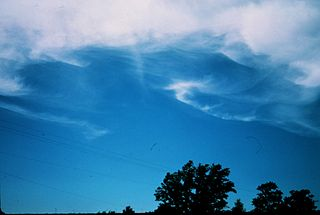The Theme of Current Research in Environmental Chemistry
Who Needs a Rain Dance?
Cloud seeding is not a new field. States such as Utah have used large-scale cloud seeding programs to increase winter precipitation since the 1970s. Recently, there has been a bit of a twist. Climate scientists at Yale University want to reduce the optical thickness of cirrus ice clouds to cool the earth.
Cirrus clouds are important. Studying them has made it possible to make climate change predictions. A seemingly small change in cirrus coverage drastically shifts the predictions from general circulation models (GCMs).

According to most textbooks, cirrus clouds do not contain any liquid water, rather they are comprised of ice crystals. These clouds are found in the upper troposphere. These wispy clouds tend to develop primarily over ice-supersaturated regions such as the poles. They are effective trappers of longwave radiation and so have a warming effect on the planet. (Source)
Awkwardly worded sentences aside, here's the down low on this Tawhirmatean task. Cirrus clouds are found in the upper troposphere and have a warming effect on the planet. Climate scientists Trude Storelvmo of Yale University believes that thinning these clouds will have a cooling effect on the Earth17. It's akin to taking an already thin blanket and stretching it out to twice its normal size. (Come on, we all do that to our blankets). The thinner blanket won't keep you as warm. It's the same idea with the clouds. The thinner clouds will allow more solar radiation to escape, thus decreasing temperatures.
This new suggestion is not the first time scientists have suggested we play around with cirrus clouds. In 2009, researchers from the Desert Research Institute in Nevada suggested seeding cirrus clouds to catalyze the formation of ice crystals. The general idea was to make the clouds have fewer, but larger, ice crystals. This could make the cloud more transparent, letting more radiation escape to space. The net result would be a decrease in temperatures. It would also result in a decrease in atmospheric water vapor (which is a greenhouse gas) and again the result is cooling.
In addition to making the cloud thinner, this technique of cloud seeding could also decrease its expected life span from a day to, well, less than a day (sorry, this information is so current we were not able to find the exact number).
One of the species that would be used to seed cirrus clouds is bismuth (III) iodide, a relatively cheap and non-toxic chemical. A challenge of cloud seeding is knowing how much of the seed particles to add. If you add too few, you don't really change the clouds at all. If you add too many, you might end up with even thicker clouds and increasing temperatures1.

Cloud seeding can also be used to cause precipitation to fall. The drops have to be large enough and fast enough to avoid evaporating before they reach the ground. Cloud-seeding can accomplish this12. Cloud-seeding has also been used to decrease the size of hail. This ground-based silver iodide generator in Colorado is most likely used to produce snow. (Source)